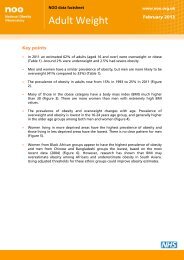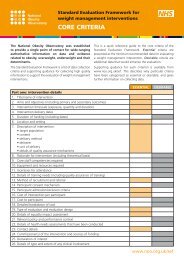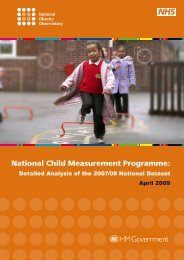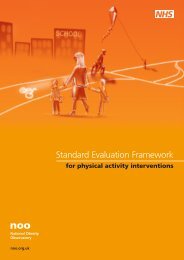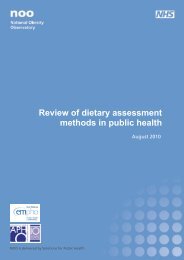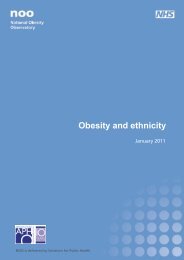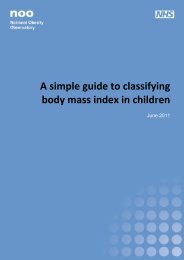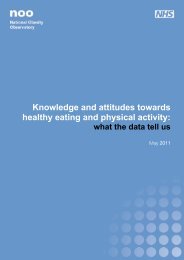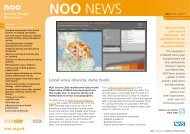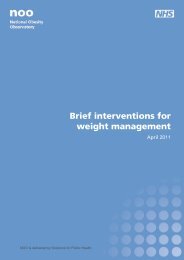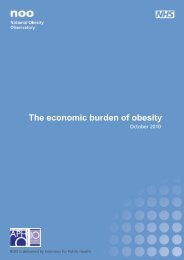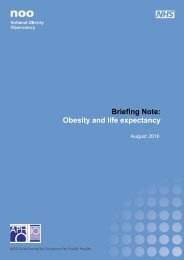Measures of central adiposity as an indicator of obesity - National ...
Measures of central adiposity as an indicator of obesity - National ...
Measures of central adiposity as an indicator of obesity - National ...
Create successful ePaper yourself
Turn your PDF publications into a flip-book with our unique Google optimized e-Paper software.
Executive summary<br />
Obesity h<strong>as</strong> long been identified <strong>as</strong> <strong>an</strong> import<strong>an</strong>t risk factor for a number <strong>of</strong><br />
health problems. Body M<strong>as</strong>s Index (BMI), the most frequently used me<strong>as</strong>ure to<br />
determine levels <strong>of</strong> body fat, provides a proxy me<strong>as</strong>ure <strong>of</strong> total <strong>adiposity</strong> (the<br />
amount <strong>of</strong> fat around the body), but a number <strong>of</strong> studies have suggested that<br />
the accumulation <strong>of</strong> body fat around the waist (<strong>central</strong> or abdominal <strong>adiposity</strong>)<br />
may present a higher risk to health th<strong>an</strong> fat deposited in other parts <strong>of</strong> the<br />
body.<br />
High levels <strong>of</strong> <strong>central</strong> <strong>adiposity</strong> in adults are known to be <strong>as</strong>sociated with<br />
incre<strong>as</strong>ed risk <strong>of</strong> <strong>obesity</strong>-related conditions including type 2 diabetes,<br />
hypertension <strong>an</strong>d heart dise<strong>as</strong>e. Although me<strong>as</strong>ures <strong>of</strong> <strong>central</strong> <strong>adiposity</strong> are<br />
closely correlated with BMI, they have been shown to predict future ill health<br />
independently <strong>of</strong> BMI.<br />
The best evidence to date suggests that me<strong>as</strong>ures <strong>of</strong> general <strong>an</strong>d <strong>central</strong><br />
<strong>adiposity</strong> should be used together in order to best identify individuals at<br />
incre<strong>as</strong>ed risk <strong>of</strong> <strong>obesity</strong>-related ill health.<br />
It is not clear from the research published to date what constitutes the best<br />
me<strong>as</strong>ure <strong>of</strong> <strong>central</strong> <strong>adiposity</strong> in terms <strong>of</strong> predicting ill health or mortality, <strong>an</strong>d<br />
this may differ by age, sex, ethnicity, or by the dise<strong>as</strong>e being studied. Waist<br />
circumference h<strong>as</strong> been most frequently investigated in the published literature<br />
<strong>an</strong>d, given that this me<strong>as</strong>ure is more e<strong>as</strong>ily recorded <strong>an</strong>d interpreted th<strong>an</strong><br />
alternatives such <strong>as</strong> weight-to-hip or weight-to-height ratios, this currently<br />
seems to be the most appropriate option among me<strong>as</strong>ures <strong>of</strong> <strong>central</strong> <strong>adiposity</strong><br />
for most public health purposes.<br />
The World Health Org<strong>an</strong>ization (WHO) h<strong>as</strong> advised that <strong>an</strong> individual’s relative<br />
risk <strong>of</strong> <strong>obesity</strong>-related ill health c<strong>an</strong> be more accurately cl<strong>as</strong>sified using both BMI<br />
<strong>an</strong>d waist circumference th<strong>an</strong> by either alone. WHO h<strong>as</strong> developed a set <strong>of</strong><br />
thresholds to categorise <strong>an</strong> individual’s risk <strong>of</strong> <strong>obesity</strong>-related illness b<strong>as</strong>ed on<br />
BMI <strong>an</strong>d waist circumference. The <strong>National</strong> Institute for Health <strong>an</strong>d Clinical<br />
Excellence (NICE) h<strong>as</strong> also endorsed these thresholds for use in the UK. Using the<br />
WHO cl<strong>as</strong>sification, over 50% <strong>of</strong> both men <strong>an</strong>d women in Engl<strong>an</strong>d were at<br />
incre<strong>as</strong>ed risk <strong>of</strong> <strong>obesity</strong>-related ill health, according to the Health Survey for<br />
Engl<strong>an</strong>d (HSE) 2007.<br />
People <strong>of</strong> South Asi<strong>an</strong> origin seem more prone to carrying excess fat <strong>central</strong>ly<br />
th<strong>an</strong> the White population <strong>an</strong>d show raised <strong>obesity</strong>-related risk at lower BMI<br />
<strong>an</strong>d lower waist circumference levels. Therefore it is particularly import<strong>an</strong>t for<br />
South Asi<strong>an</strong> populations in the UK to be aware <strong>of</strong> the health risks <strong>of</strong> incre<strong>as</strong>ed<br />
waist circumference.<br />
NOO │ MEASURES OF CENTRAL ADIPOSITY AS AN INDICATOR OF OBESITY 1



